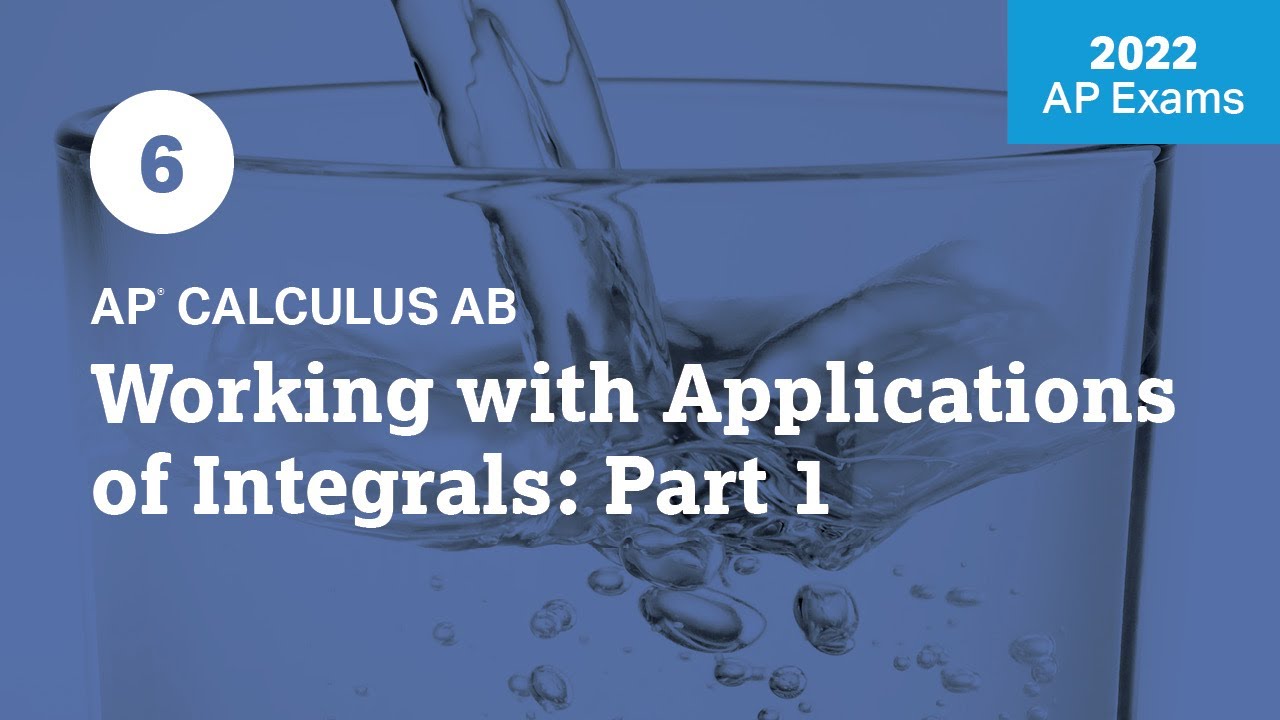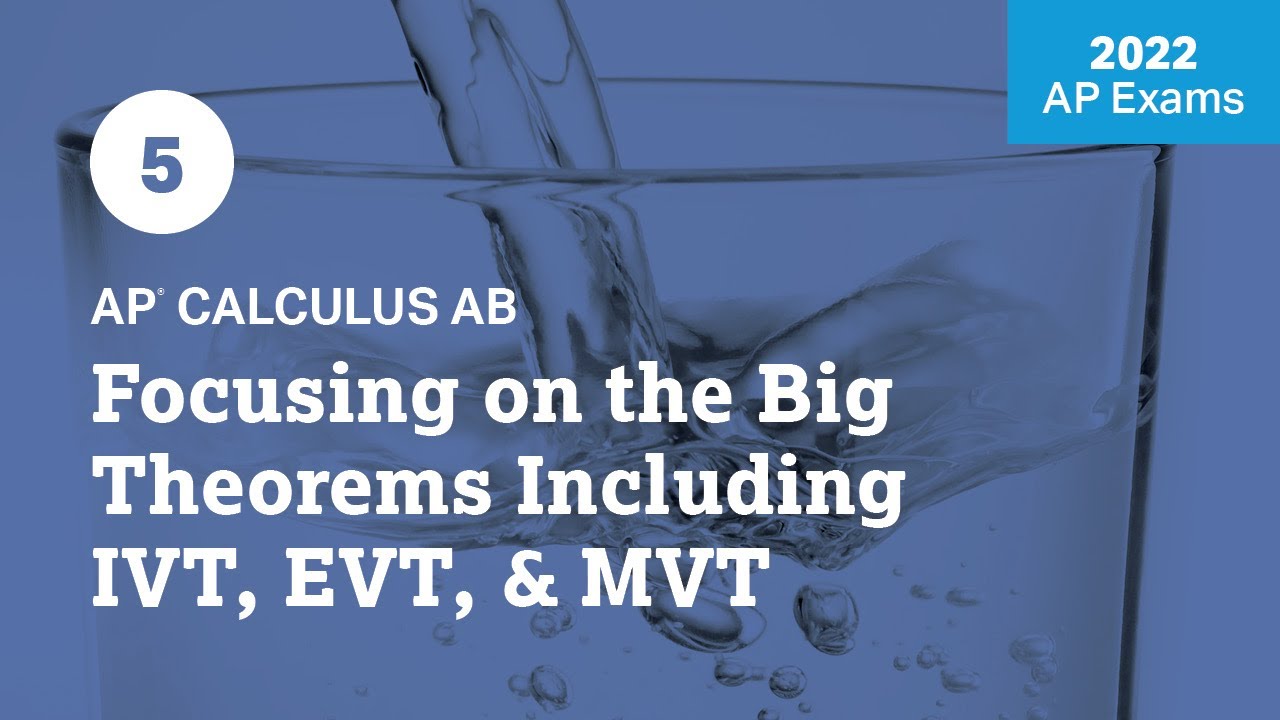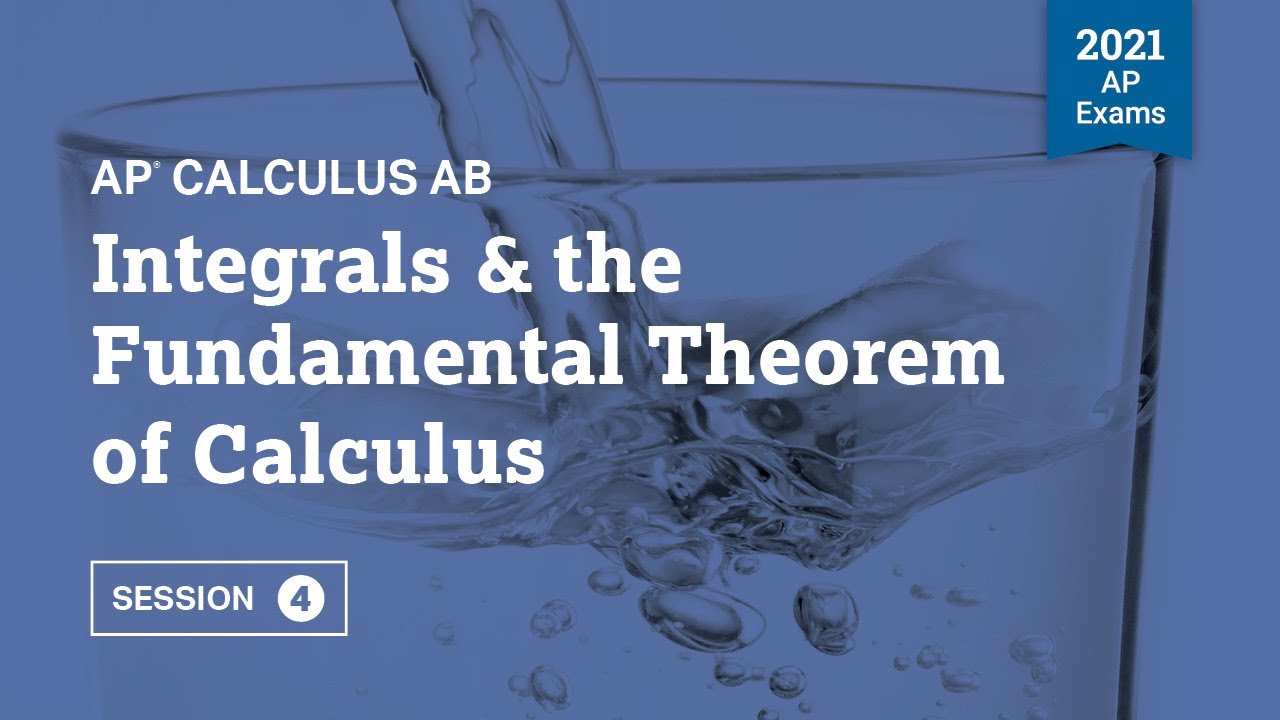2021 Live Review 6 | AP Calculus AB | Application of Integrals (Part 1)
TLDRThe video script features a dynamic and informative session where the hosts, Mark and Verge, engage in a detailed discussion on calculus concepts, specifically focusing on applications of integrals and differential equations. They delve into particle motion, slope fields, and accumulation models, using real-time examples to illustrate their points. The hosts also address the importance of understanding the difference between total distance traveled and displacement in particle motion problems. Throughout the session, they provide practical advice for students preparing for AP exams, including strategies for solving calculus problems and navigating the nuances of the exam format. The conversation is interspersed with humor and personal anecdotes, making the content accessible and relatable. The session concludes with a reminder about the importance of showing work and the upcoming topics for the next day's lesson.
Takeaways
- 📚 **Understanding Integral Applications**: The session focuses on applications of integrals, including particle motion, differential equations, slope fields, and accumulation, which are crucial for calculus students.
- 🧮 **No Calculator for Displacement**: For finding the displacement of the toy car, a no-calculator approach was emphasized, highlighting the importance of understanding the concept without relying on technology.
- 🔢 **Fundamental Theorem of Calculus**: The use of the Fundamental Theorem of Calculus is demonstrated in finding displacement, showing how antiderivatives relate to the definite integral of a velocity function.
- 📈 **Total Distance vs. Displacement**: A clear distinction is made between total distance traveled and displacement, noting that total distance is always a non-negative value and involves the absolute value of velocity.
- 📉 **Slope Fields and Differential Equations**: The session explains how to determine which differential equation corresponds to a given slope field by analyzing the dependence on x and y values.
- ✍️ **Clear Pen Usage Caution**: Erasable pens are recommended for general use but are cautioned against for AP exams or any situation where heat might cause the ink to disappear.
- 🔍 **Detail-Oriented Approach**: Attention to detail is stressed, from the careful setup of integrals to the importance of showing all steps in calculations, especially for AP exam responses.
- 📐 **Graphing and Slope Fields**: Techniques for graphing slope fields and how to use them to understand the behavior of differential equations are covered, including how to find horizontal and vertical tangents.
- ⏱️ **Timely Problem-Solving**: The session emphasizes the importance of time management and pacing during the AP exam, particularly when solving multi-part free response questions.
- 🔧 **Use of Technology**: The use of graphing calculators is explored for solving calculus problems, including finding antiderivatives and setting up integrals for both distance and displacement.
- 📝 **Documentation of Steps**: It is highlighted that showing each step of the problem-solving process is essential for earning full credit on exam questions, avoiding 'bald answers' that lack supporting work.
Q & A
What is the main topic of discussion in the video?
-The main topic of discussion in the video is the application of integrals in calculus, specifically particle motion, differential equations, slope fields, and accumulation models.
What is the significance of the date 'April 27th' mentioned in the video?
-The date 'April 27th' is significant because it is used to reference a specific folder in the Google Drive where the educational content is stored. It is also noted for being a mathematically interesting date as it represents the product of two prime numbers (2 squared times 3 cubed).
What is the concept of 'displacement' in the context of the video?
-In the context of the video, 'displacement' refers to the change in position of an object, which is calculated by integrating the velocity function over a given time interval. It is a vector quantity that represents the shortest distance from the initial to the final position, taking direction into account.
What is the difference between total distance traveled and displacement?
-Total distance traveled is the sum of the lengths of all the paths taken by an object, regardless of direction, similar to an odometer reading. Displacement, on the other hand, is the straight-line distance from the starting point to the ending point and is a vector quantity, taking into account the direction of motion.
What is a slope field and how is it used in the context of differential equations?
-A slope field is a graphical representation of the slopes of various tangent lines at different points on a grid, often used to visualize the solutions to differential equations. It helps in understanding the behavior of the solutions and can be used to approximate the path of a solution without explicitly solving the differential equation.
How does the video instructor approach the problem of finding the total distance traveled by the cat?
-The instructor approaches the problem by integrating the absolute value of the velocity function of the cat over the time interval from 0 to 4 minutes. This is done using a calculator to find the total distance traveled, as it accounts for all the changes in direction of the cat's movement.
What is the importance of showing work in AP Calculus exams?
-Showing work in AP Calculus exams is crucial because it demonstrates the student's understanding of the problem-solving process and allows the grader to follow the student's line of reasoning. It also prevents 'bald answers', which are answers without mathematical support, that rarely earn full credit.
What is the role of the initial condition in solving differential equations?
-The initial condition provides the necessary starting point to solve for the constant of integration in a differential equation, thereby finding a particular solution that satisfies both the differential equation and the initial condition.
Why does the instructor emphasize the importance of not leaving pens in the car, especially erasable ones?
-The instructor emphasizes this because erasable pens use heat-sensitive ink that can disappear when exposed to high temperatures, such as those that may occur inside a car when it's hot outside. This can lead to loss of important written information, like exam answers or graded papers.
What is the strategy for solving for the particular solution of a differential equation in the video?
-The strategy involves four steps: separating the variables, integrating both sides of the equation, solving for the constant of integration using the initial condition, and finally solving for the function y to get the particular solution.
How does the video instructor use technology to solve calculus problems?
-The instructor uses a graphing calculator to perform integration, differentiation, and to solve equations. The calculator is used to find antiderivatives, evaluate definite integrals, and to graph functions and slope fields, which helps in visualizing and solving calculus problems.
Outlines
😀 Introduction and Overview of Lesson
Mark and Verg discuss their coincidental attire and the calculus that leads to such occurrences. They express excitement about the day's lesson, which includes applications of integrals, particle motion, differential equations, slope fields, and accumulation. They mention a warm-up problem involving a toy car's displacement and the importance of recognizing accumulation models in various problems. They also provide a link to a Google Drive folder for additional resources.
🧮 Solving the Warm-Up Problem
The video script details the process of solving a warm-up problem involving the displacement of a toy car. The integral of the car's velocity function from time t=2 to t=9 is calculated to find the displacement. The problem is worked through step by step, using the reverse power rule and evaluating the antiderivative. The total distance traveled is also discussed, and the final answer is obtained after evaluating the expression at the given limits.
📝 Discussion on Erasable Pens and Exam Advice
The speakers talk about the pens they use, addressing feedback from viewers. They explain the heat sensitivity of erasable pen ink and caution against using them on exams like the AP tests due to the risk of ink disappearing in hot conditions. They share anecdotes about teachers losing graded comments due to the pens' sensitivity and emphasize the need for care when handling such pens.
📈 Analyzing Slope Fields and Differential Equations
The paragraph focuses on slope fields and their relation to differential equations. The speakers discuss how to determine if a given slope field corresponds to a particular differential equation. They highlight the importance of looking at columns and rows in the slope field to deduce the equation's dependence on x and y. They also demonstrate how to test a point against a potential differential equation to verify if it fits the slope field.
🍰 Cooling Apple Pie Differential Equation
This section deals with a differential equation problem involving an apple pie cooling on a kitchen counter. The temperature of the pie is modeled by a function, and the differential equation is given. The problem asks for the particular solution to the equation to predict the pie's temperature after 10 minutes. The solution process involves separating variables, integrating, and applying initial conditions to find the constant of integration.
😄 Jokes, Exam Tips, and Final Thoughts
The speakers wrap up the lesson with a joke about teaching calculus to a lumberjack and a personal anecdote about wearing a flannel shirt when introducing logarithms. They emphasize the importance of understanding the concepts of total distance and displacement in particle motion. They also discuss the structure of AP exam questions, including multiple-choice and free-response questions, and the significance of each question's points towards the overall score.
🏃♀️ Calculating Displacement and Distance of a Cat Chasing a Mouse
The paragraph discusses a problem involving a cat chasing a mouse, where the cat's velocity is given by a function of time. The problem requires finding the total distance the cat has traveled between 0 and 4 minutes. The speakers differentiate between total distance and displacement, noting that total distance accumulates regardless of direction. They demonstrate how to use a calculator to find the integral of the absolute value of the velocity function over the given interval.
🚶♀️ Claire's Velocity and Displacement Calculations
This section involves a problem about Claire's motion, where her velocity is described by a function of time. The task is to calculate her displacement from 0 to 45 minutes. The speakers explain the concept of displacement as the integral of velocity and demonstrate how to use a calculator to find the integral. They also emphasize the need to show all work and not just provide the final numerical answer, as this is crucial for earning credit on exams.
📊 Average Velocity and Intersection Calculations
The speakers calculate the average velocity of Claire's motion over the 45-minute interval and find the time at which her instantaneous velocity equals the average velocity. They use the calculator to find the intersection of the velocity function with the average velocity value. The mathematical process is explained, and the importance of providing justification for the answer is highlighted.
🔢 Speed Analysis and Final Exam Tips
The final paragraph discusses determining whether Claire's speed is increasing or decreasing at a specific time. The speakers demonstrate how to use a calculator to find the derivative of the absolute value of the velocity function and how to interpret the result. They also provide alternative methods for analyzing the problem without a calculator. The paragraph concludes with a summary of key takeaways from the lesson and a reminder about the importance of showing all mathematical work on exams.
Mindmap
Keywords
💡Integral
💡Displacement
💡Total Distance
💡Velocity
💡Differential Equation
💡Slope Field
💡Anti-Derivative
💡Initial Condition
💡Chain Rule
💡Separation of Variables
💡Free Response Question
Highlights
Mark and Verge discuss the importance of recognizing accumulation models in calculus problems.
An interesting observation is made about how often people unknowingly wear the same outfit, indicating a non-verbal form of communication.
The concept of displacement in particle motion is explored through an integral calculus problem.
A detailed walkthrough of solving an integral for the displacement of a toy car, highlighting the use of anti-derivatives and the fundamental theorem of calculus.
The use of erasable pens is discussed, with a cautionary note about their potential issues in heat.
A unique approach to learning calculus is presented through the use of engaging stories and scenarios, such as a cat chasing a mouse.
The total distance traveled, as opposed to displacement, is explained using the analogy of an odometer reading.
An in-depth explanation of how to solve differential equations using separation of variables is provided.
The importance of showing work on AP exams is emphasized, as 'bald answers' often receive lower scores.
A practical application of calculus is demonstrated through the problem of predicting the cooling of an apple pie.
The concept of a slope field in differential equations is introduced and related to the visual representation of equations.
Tips are given for solving multiple-choice and free-response questions on AP calculus exams, including the use of technology.
An example of how to determine whether a given differential equation matches a provided slope field is shown.
The significance of understanding the direction of travel (e.g., east-west) when interpreting calculus problems is discussed.
A comprehensive strategy for tackling rate and rate out problems, common in AP calculus, is outlined.
The session concludes with a reminder of the importance of practice and the availability of resources to help with understanding calculus concepts.
Transcripts
Browse More Related Video

2022 Live Review 6 | AP Calculus AB | Working with Applications of Integrals: Part 1

2022 Live Review 5 | AP Calculus AB | Focusing on the Big Theorems Including IVT, EVT, & MVT

2021 Live Review 4 | AP Calculus AB | Integrals & the Fundamental Theorem of Calculus

2021 Live Review 3 | AP Calculus BC | Everything You Need to Know About Parametrics

8 | FRQ (No Calculator) | Practice Sessions | AP Calculus AB

2022 Live Review 8 | AP Calculus AB | Reviewing Multiple-Choice & Free-Response Questions
5.0 / 5 (0 votes)
Thanks for rating: